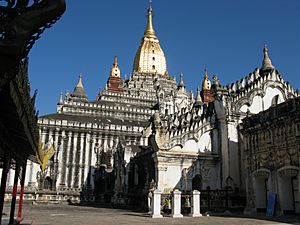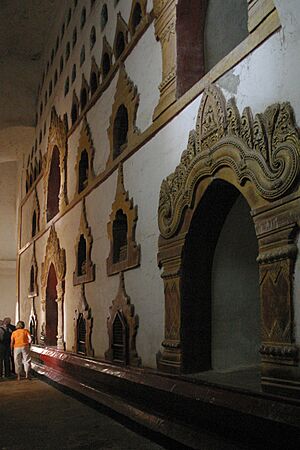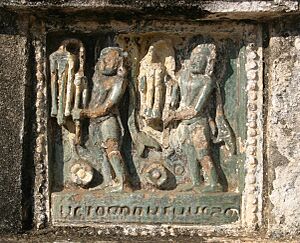Ananda Temple facts for kids
Quick facts for kids Ananda Templeအာနန္ဒာဘုရား |
|
|---|---|

Ananda Temple
|
|
| Religion | |
| Affiliation | Theravada Buddhism |
| Location | |
| Location | Bagan, Myanmar |
| Country | Myanmar |
| Architecture | |
| Founder | Kyansittha |
| Groundbreaking | c. 1090 |
| Completed | 1105 |
| Specifications | |
| Height (max) | 51 m (167 ft) |
| Spire height | ? |
The Ananda Temple (Burmese: အာနန္ဒာ ဘုရား) is a famous Buddhist temple in Bagan, Myanmar. It was built in 1105 AD by King Kyansittha of the Pagan Dynasty. This temple is known for its amazing design, which mixes styles from the Mon people and India.
The temple has a unique cross shape with many levels leading up to a small pagoda at the top. This pagoda is topped with a special umbrella called a hti, which is common on temples in Myanmar. Inside, you'll find four large standing Buddha statues, each facing a different main direction (East, North, West, South). People sometimes call it the "Westminster Abbey of Burma" because it's so grand.
The Ananda Temple was damaged in an earthquake in 1975. But it has been fully fixed and is kept in great condition. In 1990, for its 900th birthday, the temple's spires were covered in gold. It is a very important and respected temple in Bagan.
Contents
What's in a Name?
The name Ananda comes from Venerable Ananda, who was Buddha's cousin and a very loyal helper. The temple was once called Ananta Temple. This name came from a Sanskrit phrase meaning "endless wisdom."
However, the word 'Ānanda' in languages like Pali and Sanskrit means "bliss" or "joy." It's a popular name in Buddhist and Hindu cultures. The temple's name, Ananda, celebrates Buddha's infinite wisdom.
A Story from the Past
There's a story about how this temple was built. Eight monks visited King Kyansittha and described a beautiful cave temple in the Himalayas. The King was so impressed by their description that he asked them to build a similar temple in Bagan. He wanted a cool and unique temple in the middle of the plains.
After the monks finished building the temple, the King wanted to make sure no other temple like it would ever be built. So, he made sure the architects (the monks) could not build another one.
History of the Temple
King Kyansittha is given credit for building this perfectly designed temple in 1105. Its construction marks the end of an early building style in Bagan and the start of a new one. The King was a follower of Theravada Buddhism. He wanted to share Buddha's teachings with his people in a clear way through this temple. He hoped it would bring people together and create excitement about their religion.
The King wanted to show his strong belief in Buddhist ideas. He aimed to:
- Make all holy scriptures clear and correct.
- Share the Law (Buddhist teachings) like a loud drum.
- Wake up people who were not paying attention.
- Always follow the commandments.
Through the temple's unique stone images, special plaques, and Buddha statues, King Kyansittha wanted to teach his people. He used the temple's design to share his beliefs in a visual way. This King became famous for his work in Buddhist architecture.
Building Styles Over Time
Experts have studied the temple's building history a lot. While it shows Mon architecture from Burma, it also clearly has strong influences from Indian temples, especially from Bengal and Orissa. An archaeologist named Duroiselle said that the people who designed and built the Ananda Temple were definitely Indian. He noted that everything, from the top to the bottom, and all the sculptures, showed Indian skill. He even called it an "Indian temple" built in Burma. Some say its design is very similar to the Ananta cave temple in Udayagiri hills in Odisha.
The Indian government is helping to restore parts of the temple.
Temple Design
The Ananda Temple is a perfectly designed building. It blends Mon and Indian styles and is a main monument in the Pagan valley. It was built using bricks and plaster. The temple features stone images and glazed terra-cotta tiles. Its main goal was to teach people about Theravada Buddhism and King Kyansittha's personal beliefs.
How the Temple is Laid Out
The temple has a simple corridor design. Its central square is about 53 meters (174 feet) wide. Gabled porches stick out about 17 meters (57 feet) from each side of the square. The top part of the temple is 51 meters (167 feet) tall, made of decorated terraces. The whole temple is about 88 meters (290 feet) long from end to end.
The temple has a cross shape. It has a main base with two curved roofs above it, then four more terraces. These four terraces lead to the top, where there's a small pagoda and a hti (umbrella ornament). The very center of the temple is a cube shape. Inside this cube are four huge standing Buddha statues, each about 9.5 meters (31 feet) tall. They stand on a 2.4-meter (8-foot) high throne. The spire rises above this cube.
Two passages go around the central cube. Each side of the cube has a large Buddha image. The four entrances have carved teak wood doors and form a perfect cross shape. A small stupa sits on top of each entrance. There are 554 terra cotta tiles decorating the base and terraces. These tiles show scenes from the Jataka tales, which are stories about Buddha's past lives. Each niche inside the four entrances holds a gilded standing Buddha statue that people worship.
The two circular passages have arched roofs. In these inner passages, around the central cube, there are 80 large carvings made from volcanic rocks. These carvings show scenes from Buddha's life, from birth to death. There are also cross passages that connect the porches to the standing Buddha images.
The outside walls of the temple are about 12 meters (39 feet) tall. They are decorated with strong walls. Each corner has a round pagoda.
The Four Buddhas
The four standing Buddhas are covered in gold leaf. Each Buddha faces a different direction, from north to south. They are said to represent reaching a state of nirvana. Each Buddha has a special name:
- Kassapa faces south.
- Kakusandha faces north.
- Konagamana faces east.
- Gautama faces west.
The Buddhas facing north and south are believed to be the original ones. They show the dhammachakka mudra, a hand position that means Buddha's first sermon. The other two Buddhas were replaced after the originals were destroyed by fires. All four statues are made of solid teak wood. Some say the southern image is made of a bronze mix. These four Buddhas show Buddha's presence everywhere, through all time and space.
The original south-facing Buddha (Kassapa) has a cool feature. When you look at it up close, it seems to have a sad expression. But when you look at it from far away, it looks joyful!
The east and west-facing Buddha images are in a newer style. The east-facing Buddha (Kongamana) holds a small, nut-like sphere between its thumb and middle finger. This is said to be a herb. It means that Buddha's teachings (dhamma) can cure sadness and problems. This hand position is rare in other Buddhist sculptures.
The west-facing Buddha, called Gautama, shows the abhaya mudra. This is a hand gesture that means fearlessness. At the feet of this Buddha, there are two life-size statues made of lacquer. One shows King Kyanzittha kneeling in prayer. The other is Shin Arahan, a Mon monk who helped the King become a follower of Theravada Buddhism. The western entrance also has two symbols of Buddha's footprints. An old writing near the King's statue says that the King saw himself as a special being who would help others.
Special Plaques
Plaques are a unique part of the temple. They are made of glazed Terra-cotta tiles, and each one tells a story from the Jataka tales. You can see many plaques on the temple walls and terraces.
- At the base, from south to west, there are 552 images of Mara's warriors trying to attack Buddha, and a parade of gods.
- From west to the north entrance, warriors are shown being defeated by Buddha's powers.
- From the southwest corner of the first terrace to the north side of the third terrace, there are 537 plaques. Each one tells a specific Jataka story.
- On the northern side of the second terrace up to the fifth terrace, you'll see pictures from the Tey Mi Jataka.
- The fifth terrace has 547 plaques of stories from the Vessantara Jataka in two parts. The second part on the roof has 375 plaques of the last ten Jatakas.
- The last ten lives of the Buddha are shown in green plaques.
You can even see pictures of camels on some plaques, which shows that trade routes influenced the area.
Stone Carvings
The stone sculptures in the outer arched hallways are considered very special in Bagan. There are about 1500 stone images inside the temple, though many are hard to see due to age. Special carvings made from a single rock show 80 events from Buddha's life. There are also 40 events from Buddha's last life. These include images of Setaketu Deva and Prince Siddhartha looking at his wife Yasodhara and newborn son Rahula before he left the palace to become a monk.
Wall Paintings
Most of the wall paintings inside the temple's prayer halls have been painted over with white. However, some paintings can still be seen on the south-west column of the northern hall. The Department of Archaeology of Myanmar has restored these. Some well-preserved paintings include:
- Pictures of Buddha, Arahats, and lotus flowers on the walls and ceiling of the eastern hall.
- Floral designs on the western entrance.
Other Buildings Nearby
Ananda Oakkyaung is a monastery made of red bricks. It's located very close to the Ananda Temple. It was built in 1137 AD. You can see paintings from the 18th century on its walls. An old writing says that three brothers built this monastery. A respected monk named Shin Thuddhamma Linkara lived here.
Tharabha Gate is the only remaining gate of the ancient city of Bagan. The Ananda Temple is located to its southeast. The word Tharabar comes from a Pali word meaning "shielded against arrows." Tharabar was one of 12 gates into the city of Pagan, built by King Pyinbya in 849 AD. You can still see some stucco carvings of Ogres on the gate. People believe that two spirits protect the gate: the brother "Lord of the Great Mountain" on the left and the sister "Golden face" on the right.
Museum
There is a museum near the Ananda Temple in Pagan. It's designed to help people study old objects in their original setting.
Festivals
The Ananda Temple hosts a yearly week-long festival. It happens during the month of Pyahto (December to January). During the festival, 1000 monks chant scriptures non-stop for 72 hours. Thousands of villagers from far away set up camps around the temple. On the morning of the full moon day, they offer gift bowls to the monks.
See Also
- List of tallest structures built before the 20th century












